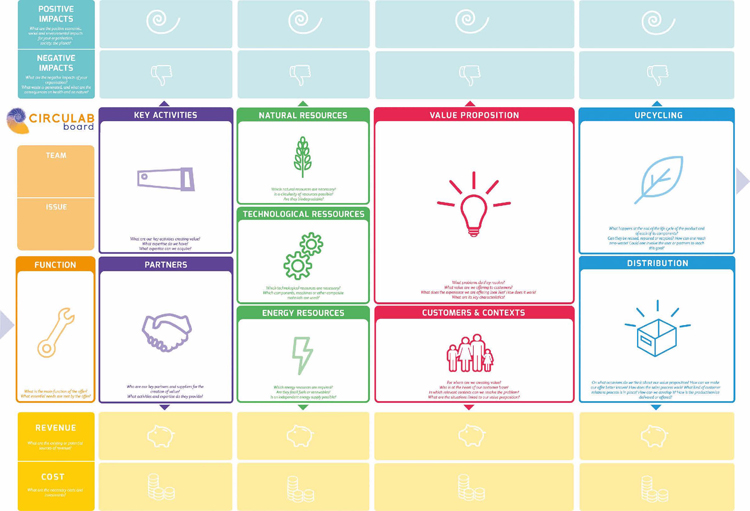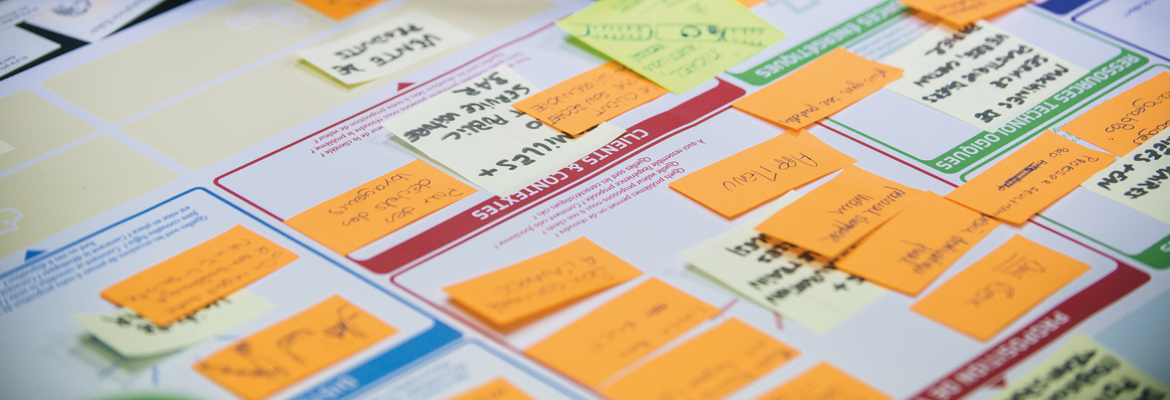Circular economy is not just about rethinking waste management, it is a whole new economical and philosophical approach to business. It is complex, diversified and therefore hard to grasp for the uninitiated. This is why Circulab has been designed. This tool has one purpose: helping people to imagine concrete ways of setting up the circular economy.
What is Wiithaa?
Founded in 2012 by two French circular economy aficionados, Wiithaa is a design agency entirely devoted to the circular economy. Wiithaa is the aboriginal name of the bowbird, an Australian bird that uses every resource he finds to build a beautiful nest to lure the opposite sex. In nature its structure is made of twigs, flowers, shells, but now it is common to find straw, plastic caps and other human-made objects in its nest. This funny little bird is an example of how waste can become a resource, and therefore of how an environmental issue can become an economic opportunity.
Wiithaa’s raison d’être is to put an end to the very notion of waste by helping companies to manage their flow of resources and energy in order to be both environmentally virtuous and economically performing.
Wiithaa works on two fronts: first, the agency trains the employees to the circular economy paradigm, helping them to seize its concepts, and then Wiithaa acts at the design stage, conceiving new products or services hand in hand with companies.
Considering that it is not easy for people to integrate this approach in their daily working life, Wiithaa created a tool: Circulab. Inspired by the board games played at home, Circulab creates an atmosphere of innovation and cooperation that enables players to trigger the circular economy logics around them.
What is Circulab?
Circulab is a set of tools that aims to consider and analyze a business model as a whole in order to co-generate more virtuous solutions for a better ecosystem integration.
A new way of designing business models
Two business philosophies are at the genesis of Circulab: design thinking and biomimicry.
Tim Brown, CEO and President at IDEO, a design and innovation agency, is one of the main “Design Thinking” evangelist. This new approach helps companies stimulate creativity and innovation. It calls for going back to users, understand their motivations and analyze contemporary issues that need to be adressed.
In order to do so there are 5 steps to focus on:
1. Emphasize: It consists in observing and interacting with users in order to better understand their experience.
2. Define: In this step, “ thinkers ” shape users’ main need.
3. Conceive: Aims at coming up with possible ideas and solutions that can solve the problem.
4. Prototype: Ideas take a physical form so that “ designers ” test and improve them.
5. Test: In this last step in-situ information and feedback are used to refine the original vision.
The second guideline of the Circulab approach is biomimicry; organizations should mimic the model through which nature has evolved over the past 3.8 billion years.
A natural ecosystem differs from human economy because it does not generate waste. The very concept of waste makes no sense in it. Someone’s waste is someone else’s resource.
Nature is by far better than us. Each species and each cell has its own function, its raison d’être.
And if each component of the ecosystem is so well designed, it is also because it cooperates. Let’s take a sequoia as an example: slugs living at its foot feed on invasive plants that consume the water and the nutrients that are essential for the tree. In return, the tree gives them cool and moist. Therefore, the sequoia multiplies positive interactions in order to increase its resilience. Indeed, the more it maintains symbiotic relationships with other species, the less it depends on one resource or species, and the more it is resistant to external disruptions. By playing Circulab, you will find yourself in a context where eco-friendly and useful innovation goes through a win-win cooperation with the other stakeholders: this is the bio-inspired mindset of Circulab.
The Circulab board game
The main component of Circulab is the board, divided into squares where the flows and interactions within the business are situated.

The 10 main squares help synthesize the current business model.
1. Function. It requires to define the “raison d’être,” the need that the activity aims to satisfy.
2. Key activities represent the organization’s know-how and activities.
3. Partnerships require to identify all the partners that take part in the activity.
4. Natural resources are all the materials used for manufacturing, distribution and final use.
5. Technological resources include the machines needed both to create the consumption process and to obtain products or services.
6. Energetic resources integrate all kinds of energy consumed in the process, including end user’s consumption.
7. The “value proposition” refers to the experience the organization offers the user: what product or service, its key characteristics and its added value.
8. “Clients and context” answers the questions: to whom are we going to sell? Which situation is more suitable to the offer?
9. Distribution tends to define how we communicate and how we sell.
10. Upcycling deals with “zero waste”. It involves the knowledge of all the leftovers components and materials after the final use, and which of those are repairable, reusable or recyclable.
The complementary squares highlight the flows and their impact on the company and its ecosystem.
The first flows are the economical fallouts. They include the incoming and outgoing streams created by the central squares. By specifying and analyzing needs and possible revenues, it helps understanding better where and why money is spent, and to consider the new revenue opportunities. Players can take into account costs and investments to achieve their goals and optimize the flows within their business.
The second flows are the positive and negative impacts of the business on its economy, environment and society. By positioning each square in its ecosystem and taking into accounts all its components, from production to actual end-of-life, it becomes easier to discern all the negative impacts caused by producing, consuming or throwing away.
Three main objectives
Circulab can serve organizations in three different ways.
First, it provides players with tools that are useful to understand the key concepts of circular economy. When they play they see right away how an organization is not only a matter of stocks, but also of flows that concern more than business models themselves. As a matter of fact, a company is part of a much larger ecosystem: considering it from this perspective is the very essence of the circular economy.
The game fosters cooperation between employees, departments, companies and territories. Each participant plays in the same team with the same goal: creating new ideas to solve a given issue. They do not compete with anybody as they are in the same boat, like us on this planet.
People from various backgrounds and professions share their skills to create something more than a simple sum of their talents. Cooperation between actors is an essential component of circular economy: when people understand the meaning of global thinking, they apply this thought pattern more easily on a daily basis.
This is the third aspect of Circulab: getting players involved. While creating new ideas, they take hold of them and, as a consequence, they feel responsible for their implementation.
 Three main principles
Three main principles
Designing regenerative business models with adapted products and services requires setting up 3 main principles, which corresponds to different degrees of Circulab use.
Exploring: Starting from a detected problem, one should strive to understand the actual business flow and know-how and its context. The problem can be related to the supply, the resilience or the design of your products or services.
This observation work allows to fill each square of the board, enhancing products and services more suitable to consumers’ needs, the organization resources and its ecosystem.
Creating by cooperation: It is time to involve all the relevant stakeholders and brainstorm on how to make the observed business model more virtuous while answering the initial issues. Players bring together their ideas to get the best options.
Taking action: Once the ideas have been conceived, the company will make the difference and be able to transform its business model by prototyping a strategy leading to new economic, social and environmental opportunities. Defining the prototype is of particular importance, since up to 70% of the social and environmental impact of a product is determined during its design. Taking action implies testing and ensuring the feasibility of an idea with the right components and design, while making sure the product or service will have the least possible negative impact for the duration of its life cycle.
What is the Circulab network?
To be used efficiently, Circulab needs to be facilitated by an external consultant. To do so, Wiithaa has started the Circulab network.
The Circulab network gathers independent consultants with various backgrounds and complementary skills, who share the same will to help companies in their journey towards circular business models.
Game facilitators
Circulab’s goal is to co-generate business models with multiple positive impacts.
Multiple skills, one approach
These consultants are from different domains; design, engineering, biomimicry, Corporate Social Responsibility, upcycling, change management or marketing, green IT or renewable energy. Such a variety of concepts and expertise plays an important role in developing the game and its application. Today, the 22 members of the Circulab network come from France, Belgium, Norway, Spain, Turkey and Canada.
Networkers support organizations so that they can come to a diagnosis and to a set of strategies and actions aimed at mitigating their impact on the ecosystem. Nevertheless, their tools and services are not all the same. In a cooperation effort, the ideal is to reach a common objective sharing the same approach that each person feeds through its expertise.
If a particular territory thinks that the creation of a virtuous circle amongst local players (citizens, public or private institutions) can lead to new economic possibilities, it can be best helped by someone from that very territory. The richness of the network lies in the fact that the business game of the circular economy can be use efficiently with an adapted local application.
Accelerating the Circular Economy
The Circulab approach shows how to reconcile business and nature. By promoting cooperation, it encourages players to consider themselves as a part of a larger ecosystem. All actors, whether it be companies, states, regions, citizens, NGOs, must see the economy through a new prism, where environmental concerns are no more a threat or a burden for business but a source of opportunities. Circulab helps people accelerating the development of this virtuous paradigm.
Info



